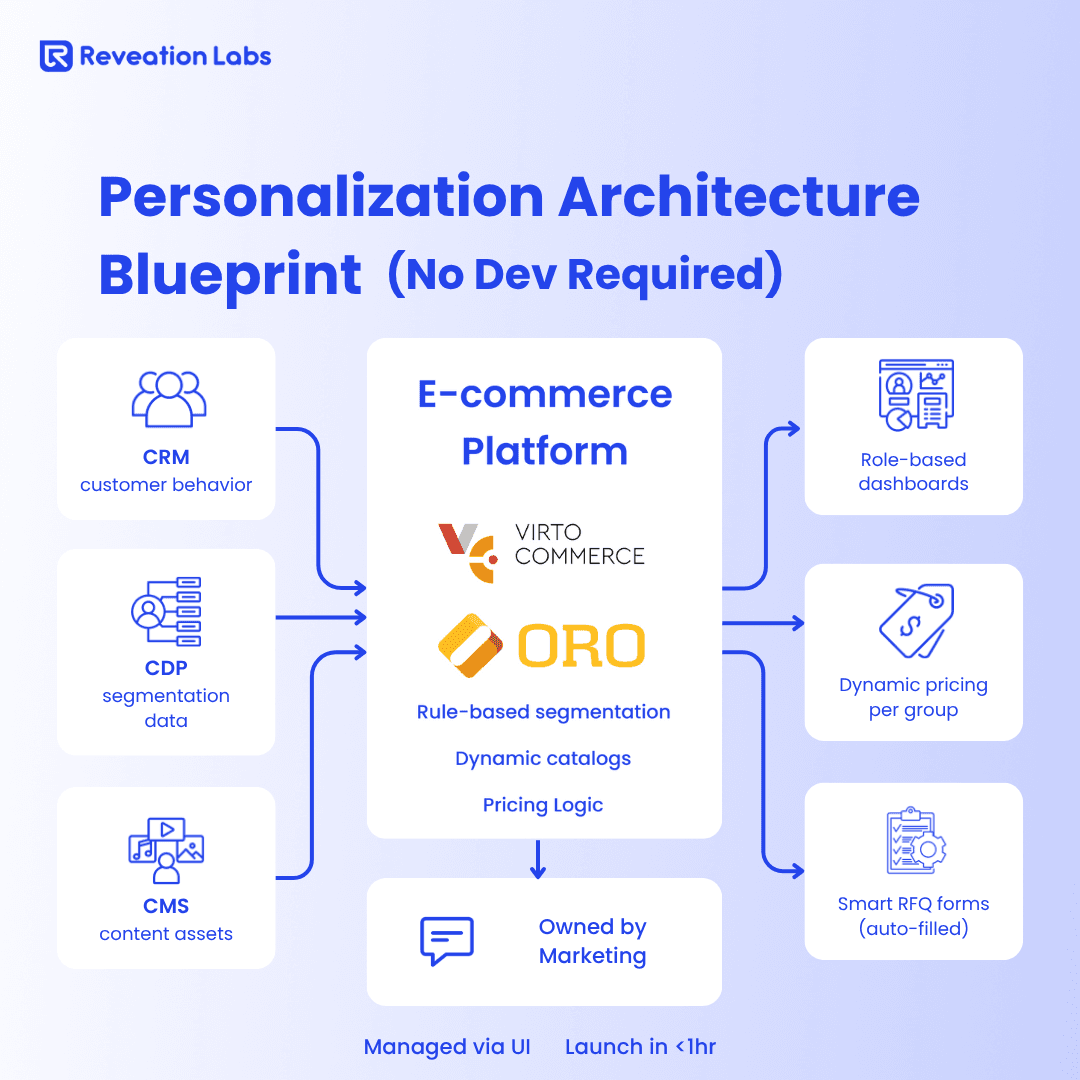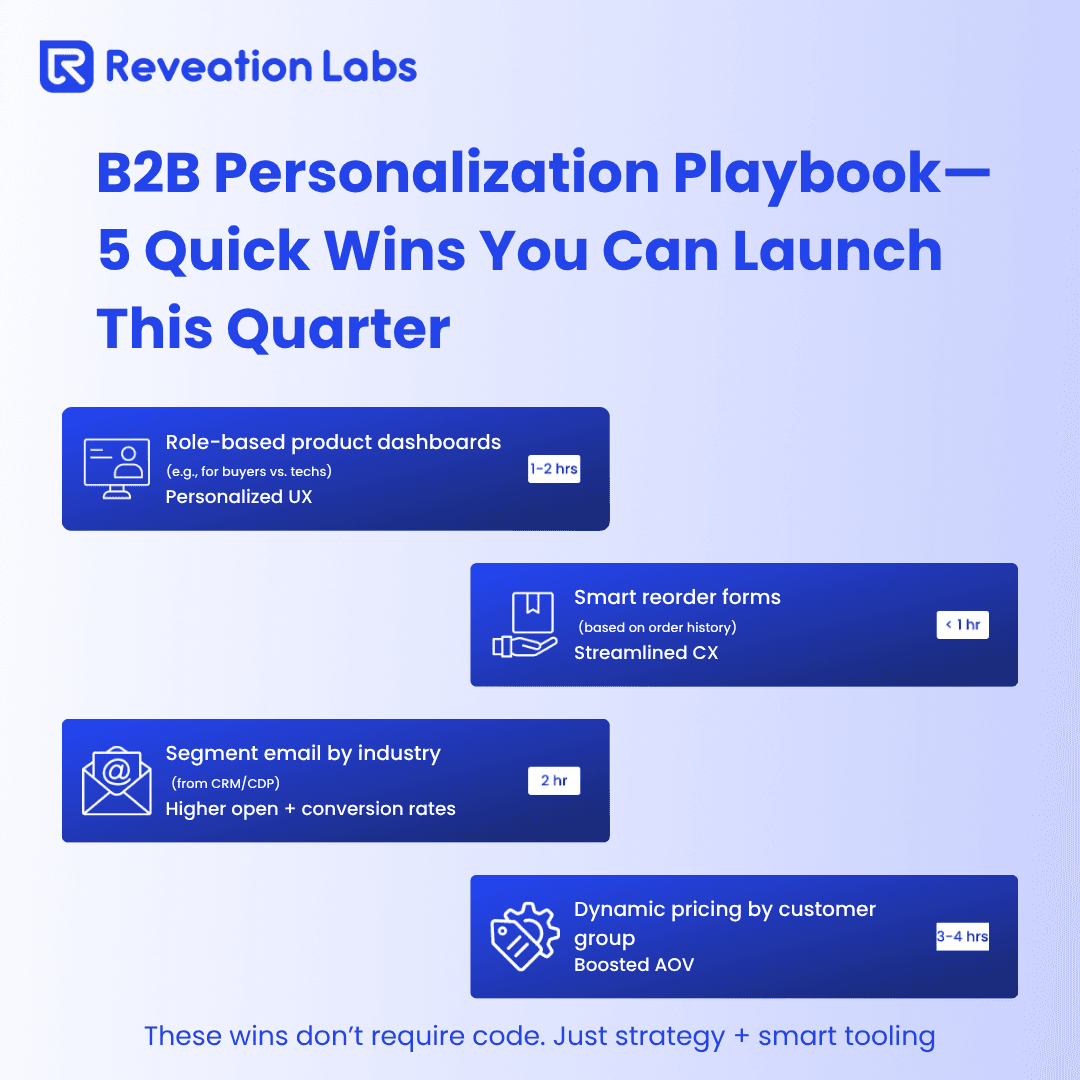Personalization in the B2B market has become an expectation. In fact, Salesforce research found that 72% of business buyers expect vendors to personalize engagement to their needs, just like they experience in B2C buying. Yet many B2B companies struggle to meet this expectation.
Often, their B2B eCommerce architecture and content management systems are rigid, and their IT teams are overloaded. The result? Personalization projects often stall or never take off.
The key is to design your B2B eCommerce architecture for agility, providing marketing with the tools to personalize content without lengthy development cycles.
What Is B2B eCommerce Architecture?
B2B eCommerce architecture is the structure that supports your online business operations. It’s the behind-the-scenes tech stack that allows your platform to manage catalogs, orders, pricing, user roles, payments, shipping, and integrations with CRMs, ERPs, and other systems.
Good B2B eCommerce architecture should:
- Handle complex pricing models
- Support multiple buyer roles and permissions
- Integrate with existing enterprise tools
- Be flexible enough to evolve with your business
Why Personalization Matters in B2B
Personalized experiences build loyalty, repeat business, and higher order values, often even more dramatically in B2B than in B2C. B2B buyers are organizations, so purchases involve multiple roles (researchers, approvers, finance, etc.) and often large, recurring orders. Tailoring that experience makes customers notice. For example:
- Higher order value and revenue: B2B companies that personalize their web experiences see about a 40% increase in order value. Personalized recommendations and targeted product bundles encourage customers to buy more each time.
- Customer loyalty: 65% of B2B buyers say they’re willing to pay more for vendors who deliver advanced digital experiences. Remembering a buyer’s preferences and simplifying their workflow keeps them coming back for repeat business.
- Improved relationships: Almost all B2B marketers (95%) report that personalization improves customer relationships. Buyers who feel understood, not just treated as a number, are more likely to trust you and extend their contracts.
- Competitive edge: Frustrated B2B buyers will switch vendors. Salesforce found that 67% of business buyers have switched suppliers for a more consumer-like experience. Offering the ease and relevance buyers expect keeps you ahead of the competition.
Personalization in B2B pays off by making complex buying simpler and showing that you understand each customer’s unique business needs. Delivering the right content, products, and prices to the right person (or role) at the right time can dramatically improve reorder rates and lifetime value.

Common Sticking Points
Despite the clear benefits, many teams hit hurdles when trying to implement personalization in B2B. Common roadblocks include:
- Rigid platforms and CMS limitations: Many legacy B2B systems weren’t built for dynamic content. Even simple updates (like changing a homepage banner, a document link, or a promotional offer) can require developer time. Analysts note that on old platforms, “even small changes can cause problems,” and deploying new features often “takes months or years”. This means every personalization tweak gets caught in long IT queues instead of being handled quickly by marketing.
- Overreliance on IT: If marketers need an IT ticket for every change, agility suffers. B2B marketers often have limited direct control over content updates. The marketing team has customer insights and ideas, but the platform is locked down. IT teams are busy with bug fixes and upgrades, so personalization initiatives stall. The solution is to move to systems where marketing can configure the experience itself.
- Data silos: Personalization requires a unified view of each customer or account. However, B2B data often lives in separate systems: CRM holds contacts, ERP tracks orders, and marketing platforms have engagement data. Research shows nearly half of organizations (47%) cite siloed data as their biggest obstacle to customer insights. When data is fragmented, you can’t reliably target the right content or offers. Bringing data into a unified profile (via a CDP or tight integrations) is essential.
These issues can be addressed with a modern B2B eCommerce architecture: one that is API-first or headless, with modular components. Such an architecture separates the concerns so marketing can update the customer experience layer without waiting on back-end changes, and data can flow between systems cleanly.
Partner with a B2B eCommerce expert to streamline your eCommerce architecture and unlock the full potential of data-driven personalization
Quick Wins: Practical Personalization Use Cases

You don’t need a massive overhaul to start personalizing your B2B site. Here are some high-impact, low-effort tactics:
- Role-Based Dashboards: Many B2B accounts have multiple users with different roles. Configure role-specific portals so each user sees what they need. For example, a warehouse manager might see inventory levels and shipment ETA, while a finance person sees credit limits and invoices. Most modern B2B platforms (like OroCommerce or Virto) let you set up user roles and tailor the UI accordingly, without heavy coding.
- Custom Catalogs & Dynamic Pricing: Present different products and prices to different customers. In B2B, it’s common to have negotiated pricing and exclusive product lists. Use a platform’s built-in personalization features: for example, assign each customer (or customer group) a personalized catalog and a specific price list. This way, Company A might see Products 1–10 at its contract prices, while Company B sees Products 5–15 at its own tiered rates, all managed through the system interface.
- Saved Lists & Quick Reorders: Simplify repeat buying. Allow customers to save shopping lists or quickly reorder past purchases. When a buyer logs in and wants to repeat a previous order, they can do it with one click instead of recreating the cart from scratch. Most B2B platforms support “saved carts” or “quick order” features out of the box.
- Targeted Content & Promotions: Use basic segmentation for banners and messages. For instance, if you know a visitor’s industry or role (perhaps from their profile or login), display a relevant banner or resource (e.g., “Top Picks for Lab Managers”). Many eCommerce CMS systems let marketers configure which content blocks or promotions to show to which segments via simple rules.
- Simple Recommendation Engines: Leverage purchase data to cross-sell. Even without advanced AI, enable a rule-based suggestion like “Customers who bought Product X also bought Y.” Many platforms have built-in recommendation widgets. This gently increases order size by promoting complementary items relevant to that buyer’s past behavior.
These “quick wins” remove friction and add relevance in the buying process. By using your platform’s features and a good segmentation strategy, you can launch personalized experiences with minimal IT involvement.
Also Read: B2B eCommerce for Manufacturers
Choosing the right tools and platforms is crucial. Here are a few that make personalization easier (and how they help):
- OroCommerce: A B2B-tailored eCommerce platform with robust personalization capabilities. Oro supports Personalized B2B Catalogs, letting you assign specific products to each customer or business unit. It also offers Multiple Price Lists, meaning you can manage unlimited price tiers for different accounts. In practice, this lets a client maintain 10 or 20 customer-specific catalogs and pricing rules out of the box. Oro’s visual workflow engine even lets marketers automate approvals and promotional rules without coding.
- Virto Commerce: An open-source, API-first B2B platform that emphasizes flexibility. Virto allows custom pricing policies and promotions for each client, and makes it easy to build detailed customer profiles so each storefront can feel tailored. For example, you can configure Virto to display a special price or an exclusive bundle only for logged-in users from Company A. Because Virto is headless, it also integrates with AI search or analytics services to enrich personalization further.
- Customer Data Platforms (CDPs): A CDP (such as ActionIQ, Segment, or Adobe Real-Time CDP) unifies customer data from web, email, CRM, and more into a single profile. This unified data can power personalized experiences. For example, if a CDP flags a visitor as a “Platinum client” (based on their order history), the site can greet them with a VIP dashboard or tailored offers. Analysts note that CDPs are now “no longer optional” for companies seeking high-performing customer experiences. We often help clients integrate CDPs so that data like web behavior and purchase history is instantly available for personalization triggers.
- CRM Integration: Syncing your commerce platform with a CRM (like Salesforce or Microsoft Dynamics) closes the loop between sales and digital experiences. For example, if Salesforce shows that Company X has special payment terms or credit limits, the eCommerce site can automatically apply those when that user logs in. Many clients use their CRM to manage account hierarchies and approvals, then sync it with their commerce site. The eCommerce platform then pulls in that account-level data so customers see only what’s relevant to them (for instance, only approved products and contract pricing for their account).
Combine these tools, and you will create a composable B2B eCommerce architecture. In practice, this means choosing a platform (Oro, Virto, etc.) with strong personalization features, and integrating it with data layers (CDP, CRM) so that everything is tailored to each buyer. Marketing teams can then configure experiences without extensive coding.
Unlock growth with B2B eCommerce Consulting, helping you streamline architecture and deliver personalised experiences that drive stronger customer engagement.
Governance: Empower Marketing to Own Personalization
Even with great technology, personalization needs the right approach. We strongly believe marketing should drive personalization strategy, not IT. Here’s how to make that happen:
- Clear ownership: Assign a marketing or digital commerce leader to run personalization initiatives. This person (or small team) defines customer segments (by industry, role, loyalty tier, etc.) and prioritizes personalization projects. IT provides the tools and integrations; marketing configures the experience.
- Marketer-friendly tools: Ensure your platform lets non-technical users make updates. A headless CMS or modern eCommerce admin should have a user-friendly interface. For example, OroCommerce’s admin UI allows marketers to add products, set up promotions, or edit content blocks without developer help. Training marketing on these tools empowers them to act quickly.
- Content operations and scaling: Personalization means more content variants. Develop templates and workflows for personalized content (emails, banners, landing sections). Create modular content pieces that can be reused and targeted. Set up an approval process that is lightweight: e.g., a marketer drafts a personalized email, a manager reviews it, and it goes live. Maintain a style guide so that even with many variants, your brand voice stays consistent.
- Iterative, data-driven process: Use analytics to measure results and refine. Provide marketing dashboards showing how each segment and personalized offer performs (e.g., open rates, click-throughs, sales). Regularly review this data to learn what resonates. When marketers can test and iterate rapidly, personalization becomes a cycle of continuous improvement rather than a one-off deployment.
When marketing owns personalization, it becomes agile and scalable. Instead of sending a helpdesk ticket for each change, marketers can deploy and test new content directly. This speed lets the company keep pace with buyer expectations, turning personalization from a technical hurdle into a competitive advantage.
Conclusion
Personalization in B2B is about smart planning and architecture. By building a flexible B2B eCommerce architecture, unifying your data, and empowering your teams, you can deliver the tailored experiences that modern business buyers expect. Start with the basics: break down data silos and choose platforms that support catalogs, pricing rules, and role-based access. Then implement practical personalization like custom catalogs, saved carts, and targeted content.
Remember: over 72% of B2B buyers now expect personalized experiences. Meeting that demand is within reach; it just requires the right setup. At Reveation Labs, we help B2B companies integrate B2B specific Ecommerce platform, CDPs, and CRMs so their marketing teams can easily manage personalization at scale.
The result is an eCommerce architecture that delights buyers with B2C-like relevance while keeping your IT team focused.
Personalization is an investment in architecture and process, not a scary new project.
Thinking To Replatform?
To Be Future-Ready!





